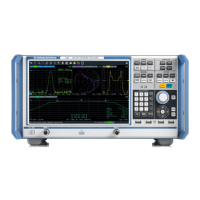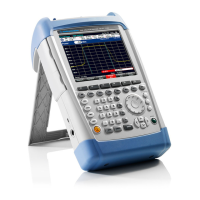Performing Configuration Tasks
R&S
®
SGS100A
148User Manual 1173.9105.02 ─ 12
To generate an I/Q modulated signal
1. Connect the test equipment. Provide the external analog signal to be modulated at
the I and Q connectors of the instrument.
The Figure 9-1 shows an example of the test setup. A signal generator, e.g. R&S
AFQ100B is used as a source of the external analog signal. The R&S signal gener-
ator provides its internal reference signal to the R&S SGS and the connected sig-
nal analyzer, e.g. the R&S FSW.
Figure 9-1: Example of the setup
Tip:
Refer to the user manual of the R&S signal generator and the R&S signal ana-
lyzer for information on how to configure the corresponding instrument.
2. Select "SGMA-GUI main panel > Instrument Name > Reference Oscillator > Ext"
and adjust the settings as required.
3. Select "SGMA-GUI main panel > Instrument Name > Frequency/Phase > LO Cou-
pling Source > Int".
Tip:
For detailed description on how to select the reference frequency source and the
LO coupling source, refer to:
● Chapter 9.4, "How to Configure the Reference Oscillator Source", on page 152
and
● Chapter 9.5, "How to Configure the Local Oscillator (LO) Coupling Source",
on page 153.
4. In the "Frequency/Phase" dialog, configure the frequency settings.
5. Select the "SGMA-GUI > Instrument Name > Level > RF Level > Level" and set
the"RF Level".
In the same dialog, configure the further "Level" and "Power-On" settings.
6. Select the "SGMA-GUI main panel > Instrument Name > I/Q settings > Analog
Impairments" and enable I/Q impairments.
How to Generate an I/Q Modulated Signal

